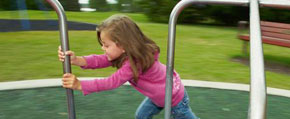We are pleased to announce an exciting new alliance between Active Living Research and GP RED to co-host and coordinate...
Associations of Perceived Environment with Walking Vary by Gender and Walking Purpose
Presentation at the 2008 Active Living Research Annual Conference
Background:
Studies have indicated gender differences in perceived environmental correlates of walking, but results are not clear. At a population level, both men and women are not walking enough (recommendation is 150 minutes per week of at least moderate intensity activity) to prevent cardiovascular and other disease conditions. It is important to understand variations in the relationship between the built environment and walking to tailor interventions to specific populations. Previous studies have not considered leisure and transportation walking separately.
Objectives:
To explore the pattern of associations between perceived environment and walking for transportation and leisure in men and women.
Methods:
Adults (N=2199) were recruited from neighborhoods in 2 cities in the US selected for variation in walkability and income. Participants completed the Neighborhood Environment Walkability Scale (NEWS) and the International Physical Activity Questionnaire (IPAQ) long version. The NEWS has 8 perceived environment subscales: aesthetics, walking/biking facilities, pedestrian safety, safety from crime, land use mix and access, residential density, street connectivity and access to recreational facilities. From the IPAQ, minutes walking per week for transport or leisure were calculated. Regression analyses were performed separately by gender and controlling for age, ethnicity and education. The association between each perceived environment subscale and walking for transport or leisure were explored separately. In addition, the interaction between gender and specific destinations (e.g. work, stores, recreation facilities, public places) within a 20 minute walk was also explored for the 2 walking outcomes.
Results:
33% of men and 31% of women reported walking for transport for 150 minutes or more each week. Significantly more (p<.001) women (27%) than men (22%) reported walking 150 or more minutes for leisure each week. Safety from crime was negatively related (p<.04) to transportation and leisure walking in men but not women. Unexpectedly, when safety from crime was higher, walking was lower. Pedestrian safety was positively correlated (p<.02) with transportation walking in men only. Aesthetics were positively related to transportation (p<.001) and leisure walking (p<.05) in men but only leisure walking in women (p<.002). Street connectivity, land use access and mix were positively correlated with transportation walking for both men (p<.001) and women (p<.003), but were related to leisure walking in men only (p<.05). Residential density was positively associated with walking for transportation and leisure in both men (p<.003) and women (p<.03). Access to physical activity facilities was positively related to walking for leisure only, in both men (p<.02) and women (p<.004). Bike/pedestrian facilities were not associated with walking for either purpose in men or women. There was a significant gender interaction for distance to work only. Women who lived within 20 minutes walk of work accumulated more minutes (255 minutes/week) walking for transport (p<.005) than women who lived more than 20 minutes away (154 minutes/week) or men who lived either near or far from their work (179 and 160 minutes/week).
Conclusions:
These results suggest that there were more perceived neighborhood environment attributes significantly related to walking in men than women. For men, traditional urban form variables such as land use, density and connectivity were related to both transport and leisure walking. In women, these were only related to transport walking. Neighborhood aesthetics and convenient recreation locations appear to be essential correlates of women’s leisure time walking. Neighborhood aesthetics were associated with walking in men, but men walked more if they perceived higher crime threat in the neighborhood. Women living close to a worksite walked more for transport than men. Understanding population-specific associations of built environment and walking can inform designers and policymakers how to accommodate everyone’s needs.
Support:
NIH grant #R01 HL67350
STAY UP TO DATE
RECENTLY ADDED TOOLS & RESOURCES
MOVE! A BLOG ABOUT ACTIVE LIVING
The "Active Living Conference" aims to break down research and practice silos and...







